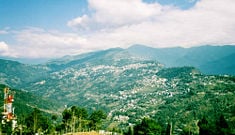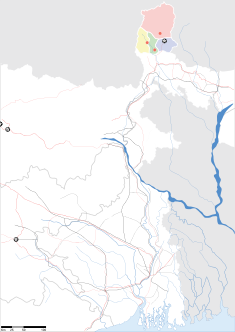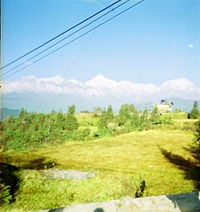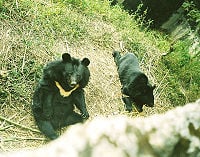Difference between revisions of "Gangtok" - New World Encyclopedia
Dan Davies (talk | contribs) (imported, credited, claimed) |
Dan Davies (talk | contribs) |
||
| Line 1: | Line 1: | ||
| − | {{claimed}} | + | {{images OK}}{{started}}{{claimed}} |
{{Infobox Indian Jurisdiction | | {{Infobox Indian Jurisdiction | | ||
native_name=Gangtok | | native_name=Gangtok | | ||
| Line 22: | Line 22: | ||
footnotes = | | footnotes = | | ||
}} | }} | ||
| − | '''Gangtok''' {{audio|Gangtok-pronunciation.ogg|pronunciation}} ([[Nepali language|Nepali]]/[[Hindi]]: गंगटोक) | + | '''Gangtok''' {{audio|Gangtok-pronunciation.ogg|pronunciation}} ([[Nepali language|Nepali]]/[[Hindi]]: गंगटोक), the [[capital]] and largest [[town]] of the [[India]]n [[states and territories of India|state]] of [[Sikkim]], situates in the lower [[Himalaya]]s, located at {{coor d|27.2|N|88.4|E|}}. Known for its clean surroundings and temperate [[climate]], this [[hill station]] of about fifty thousand people serves as the center of Sikkim's tourist industry. |
| − | Gangtok | + | Gangtok, a small hamlet until the construction of the [[Enchey Monastery]] in 1840 made it a pilgrimage center, became a major stopover between [[Tibet]] and British India at the end of the 19th century. Following [[Indian independence movement|India's independence]] in 1947, Sikkim became a [[nation-state]] with Gangtok as its capital. In 1975 the monarchy abrogated, Sikkim becoming India's twenty-second state with Gangtok remaining as its capital. |
| − | + | Although the precise meaning of the name ''Gangtok'' remains unclear, generally "lofty hill" represents the accepted meaning. Gangtok constitutes a centre of [[Tibetan Buddhist]] culture and learning with numerous [[monastery|monasteries]] and religious educational institutions. | |
==History== | ==History== | ||
{{see also|History of Sikkim}} | {{see also|History of Sikkim}} | ||
| − | + | Few records exist dealing with the early history of Gangtok. The earliest records date from the construction of the [[hermit]]ic Gangtok monastery in 1716 C.E.. Gangtok remained a small hamlet until the construction of the [[Enchey Monastery]] in 1840 made it a pilgrimage center. After the [[History of Tibet#Chinese rule|defeat of the Tibetans]] by the British, Gangtok became a major stopover in the trade between Tibet and British India at the end of the 19th century. The government built most of the roads and the [[telegraph]] in the area during that time. | |
| − | In 1894, [[Thutob Namgyal]], the Sikkimese monarch under British rule, shifted the capital from [[Tumlong]] to Gangtok, increasing its importance. | + | In 1894, [[Thutob Namgyal]], the Sikkimese monarch under British rule, shifted the capital from [[Tumlong]] to Gangtok, increasing its importance. He built a new grand palace along with other state buildings in the new capital. Following [[Indian independence movement|India's independence]] in 1947, Sikkim became a [[nation-state]] with Gangtok as its capital. Sikkim became a [[suzerainty|suzerain]] of India, with the condition that it would retain its independence, by the treaty signed between the [[Chogyal]] and the then [[Prime Minister of India|Indian Prime Minister]] [[Jawaharlal Nehru]]. Trade between India and Tibet continued to flourish through the [[Nathula]] and [[Jelepla Pass|Jelepla passes]], offshoots of the ancient [[Silk Road]] near Gangtok. The waring nations sealed those border passes after the [[Sino-Indian War]] in 1962, depriving Gangtok of its trading business. In 1975, the monarchy abrogated, Sikkim becoming India's twenty-second state, with Gangtok as its capital {{inote|Nest&Wings pg-21-24|NaW}}. |
==Geography== | ==Geography== | ||
| Line 52: | Line 52: | ||
|[[Image:Himalayanblackbear.jpg|thumb|200px|The [[Himalayan Black Bear]] seen here in the Himalayan Zoological Park.]] | |[[Image:Himalayanblackbear.jpg|thumb|200px|The [[Himalayan Black Bear]] seen here in the Himalayan Zoological Park.]] | ||
|} | |} | ||
| − | Gangtok | + | Gangtok, located at {{coor d|27.33|N|88.62|E|}}.<ref>[http://www.fallingrain.com/world/IN/29/Gangtok.html Falling Rain Genomics, Inc - Gangtok]</ref>, has an average elevation of 1437 [[metre]]s (4714 [[foot (unit of length)|feet]]). |
| − | + | Situated in the lower [[Himalaya]]s at an altitude of 1,780 [[metre]]s (5,480 [[foot (unit of length)|feet]]), in southeast Sikkim, Gangton serves as the state capital and the headquarters of the [[East Sikkim]] district. The town lies on one side of a hill, with "The Ridge," a promenade housing the [[governor]]'s residence at one end and the palace, situated at an altitude of about 6,000 feet (1,828 m), at the other. The city overlooks the [[Ranikhola]] in the valley below. Most of the roads rise steeply, with the buildings built on compacted ground alongside them. The peaks of the snow-clad Himalayan range, including the world's third tallest peak, the [[Kanchenjunga]], stand to the east of the city. | |
| − | Because of its elevation and sheltered environment, Gangtok enjoys a mild, [[temperate]] climate all year round. Like most Himalayan towns, Gangtok has five seasons: [[summer]], [[monsoon]]s, [[autumn]], [[winter]] and [[spring (season)|spring]]. Temperatures range from a high of 25 °[[Celsius|C]] (77° [[Fahrenheit|F]]) in summer to a low of about 3 °C (37 °F) in winter. [[Snow]] | + | Because of its elevation and sheltered environment, Gangtok enjoys a mild, [[temperate]] climate all year round. Like most Himalayan towns, Gangtok has five seasons: [[summer]], [[monsoon]]s, [[autumn]], [[winter]] and [[spring (season)|spring]]. Temperatures range from a high of 25 °[[Celsius|C]] (77° [[Fahrenheit|F]]) in summer to a low of about 3 °C (37 °F) in winter. [[Snow]] falls rarely, and in recent times Gangtok has received snow only in 1990, 2004 and 2005. Temperatures seldom fall below [[freezing point|freezing]]. During that season the weather may behave unpredicably, changing abruptly from bright sunshine and clear skies to heavy rain within a couple of hours. |
| − | During spring and autumn the weather | + | During spring and autumn the weather turns generally sunny and mild. Owing to its elevation, [[fog]] often envelopes Gangtok during the monsoon and winter months. Between June and September (the monsoon months), the rain often causes [[landslide]]s in the area. Labile rock formations general compose the lower Himalayas, making them prone to landslides even in dry seasons. Those landslides ocassionally result in the town being cut off from other parts of Sikkim. |
| − | Flora around Gangtok includes temperate, [[deciduous]] forests of [[poplar]], [[birch]], [[oak]], and [[elm]], as well as [[evergreen]], [[coniferous]] trees of the [[alpine climate|wet alpine]]. | + | Flora around Gangtok includes temperate, [[deciduous]] forests of [[poplar]], [[birch]], [[oak]], and [[elm]], as well as [[evergreen]], [[coniferous]] trees of the [[alpine climate|wet alpine]]. Densely forested regions of those evergreens lie just around the town. Flower shows around the city often feature a wide variety of rare [[orchids]]. [[Sunflower]], [[marigold]], [[poinsettia]], and other flowers bloom in November and December. |
[[Bamboo]] grows in abundance along the slopes of Gangtok, providing a perennial source of spring water, which originates from the roots of the trees. In the lower reaches of the town, the vegetation graduates from alpine to [[subtropical]] and temperate deciduous. | [[Bamboo]] grows in abundance along the slopes of Gangtok, providing a perennial source of spring water, which originates from the roots of the trees. In the lower reaches of the town, the vegetation graduates from alpine to [[subtropical]] and temperate deciduous. | ||
| Line 65: | Line 65: | ||
==Localities== | ==Localities== | ||
| − | The areas | + | The following areas comprise Gangtok: |
;Palzor Stadium Road | ;Palzor Stadium Road | ||
| − | Also called P.S. Road, it joins the low lying localities and suburbs with the main town. Palzor Stadium | + | Also called P.S. Road, it joins the low lying localities and suburbs with the main town. Palzor Stadium represents one of its major stops. As it nears its end, many hotels flank it , as well as the stop of the SNT or the Sikkim National Transport Buses. Some major hotels include Hotel Tibet, Hotel Mayur, Hotel Mt. Jopuno among others. The top floor of Hotel Tibet serves as the residence of the [[Dalai Lama]] when he visits Gangtok. <!--There is also a Taxi stand.—> |
;Mahtama Gandhi Road | ;Mahtama Gandhi Road | ||
| − | Also called M.G. Road, | + | Also called M.G. Road, runs through the main commercial district of Gangtok. Many shops run by members of the [[Marwari]] community or migrant Biharis thrive there. |
;Lal Bazar | ;Lal Bazar | ||
| − | + | The main market of the town occurs at the end of M.G. Road. Farmers from all over the state and adjoining areas including Nepal and Bhutan come to the market to sell their produce every weekend. | |
;Development Area | ;Development Area | ||
| − | This | + | This fairly remote area, situated at a higher altitude, has been identified by the Government for future expansion. Also called Zero Point. <!--The State Library is in this area.—> |
| − | + | The Siniolchu Lodge, located near the Enchey Monastery, represents Gangtok's highest lodge. The lodge stands close to the state's main TV transmission tower. | |
==Economy== | ==Economy== | ||
| Line 132: | Line 132: | ||
A centre of Buddhist learning and culture, Gangtok's most famous Buddhist institutions are the [[Enchey monastery]], the Do-drul Chorten stupa complex and the [[Rumtek Monastery]]. The Enchey monastery is the city's oldest monastery and is the seat of the [[Nyingma order]]. The two-hundred year old baroque monastery houses images of gods, goddesses, and other religious artifacts. In the month of January, the ''Chaam'', or masked dance, is performed with great fanfare. The Dro-dul Chorten is a stupa which was constructed in 1945 by Trulshi Rimpoché, head of the Nyingma order of [[Tibetan Buddhism]]. Inside this stupa are complete set of relics, holy books, and ''mantras''. Surrounding the edifice are 108 ''Mani Lhakor'', or prayer wheels. The complex also houses a religious school. | A centre of Buddhist learning and culture, Gangtok's most famous Buddhist institutions are the [[Enchey monastery]], the Do-drul Chorten stupa complex and the [[Rumtek Monastery]]. The Enchey monastery is the city's oldest monastery and is the seat of the [[Nyingma order]]. The two-hundred year old baroque monastery houses images of gods, goddesses, and other religious artifacts. In the month of January, the ''Chaam'', or masked dance, is performed with great fanfare. The Dro-dul Chorten is a stupa which was constructed in 1945 by Trulshi Rimpoché, head of the Nyingma order of [[Tibetan Buddhism]]. Inside this stupa are complete set of relics, holy books, and ''mantras''. Surrounding the edifice are 108 ''Mani Lhakor'', or prayer wheels. The complex also houses a religious school. | ||
| − | The [[Rumtek Monastery]] on the outskirts of the town is one of Buddhism's most sacred monasteries. The monastery is the seat of the [[Kagyu]] order, one of the major Tibetan sects, and houses some of the world's most sacred and rare [[Tibetan Buddhist]] scriptures and religious objects in its reliquary. Constructed in the 1960s, the building is modelled after a similar monastery in [[Lhasa]], [[Tibet]]. Rumtek was the focus of international media attention<ref>[http://www.time.com/time/asia/travel/magazine/0,9754,129934,00.html Losing Its Karmapa: A Monastery Goes Dark], Lara Wozniak [http://www.time.com Time Asia], | + | The [[Rumtek Monastery]] on the outskirts of the town is one of Buddhism's most sacred monasteries. The monastery is the seat of the [[Kagyu]] order, one of the major Tibetan sects, and houses some of the world's most sacred and rare [[Tibetan Buddhist]] scriptures and religious objects in its reliquary. Constructed in the 1960s, the building is modelled after a similar monastery in [[Lhasa]], [[Tibet]]. Rumtek was the focus of international media attention<ref>[http://www.time.com/time/asia/travel/magazine/0,9754,129934,00.html Losing Its Karmapa: A Monastery Goes Dark], Lara Wozniak [http://www.time.com Time Asia], 2001-06-18, Vol 157 No.24</ref> in 2000 after the seventeenth [[Karmapa]], one of the four holiest lamas, fled Lhasa and sought refuge in the monastery. |
The Namgyal Research Institute of Tibetology, better known as the Tibetology Museum, houses a huge collection of masks, Buddhist scriptures, statues, and tapestries. It has over two hundred Buddhist icons, and is a centre of study of Buddhist philosophy. The Ganesh Tok and the Hanuman Tok, dedicated to the Hindu gods [[Ganapati|Ganpati]] and [[Hanuman]] and housing important Hindu temples, are located in the upper reaches of the town. | The Namgyal Research Institute of Tibetology, better known as the Tibetology Museum, houses a huge collection of masks, Buddhist scriptures, statues, and tapestries. It has over two hundred Buddhist icons, and is a centre of study of Buddhist philosophy. The Ganesh Tok and the Hanuman Tok, dedicated to the Hindu gods [[Ganapati|Ganpati]] and [[Hanuman]] and housing important Hindu temples, are located in the upper reaches of the town. | ||
Revision as of 16:46, 6 November 2007
| Gangtok Sikkim • India | |
| Coordinates: | |
| Time zone | IST (UTC+5:30) |
| Area • Elevation |
25 km² (10 sq mi) • 1,437 m (4,715 ft) |
| District(s) | East Sikkim |
| Population • Density |
29,162 (2001) • 2,000 /km² (5,180 /sq mi) |
| Mayor | – |
| Codes • Pincode • Telephone • Vehicle |
• 737101 • +03592 • SK-01, SK-02, SK-03, SK-04 |
Coordinates: Gangtok pronunciation ▶ (Nepali/Hindi: गंगटोक), the capital and largest town of the Indian state of Sikkim, situates in the lower Himalayas, located at . Known for its clean surroundings and temperate climate, this hill station of about fifty thousand people serves as the center of Sikkim's tourist industry.
Gangtok, a small hamlet until the construction of the Enchey Monastery in 1840 made it a pilgrimage center, became a major stopover between Tibet and British India at the end of the 19th century. Following India's independence in 1947, Sikkim became a nation-state with Gangtok as its capital. In 1975 the monarchy abrogated, Sikkim becoming India's twenty-second state with Gangtok remaining as its capital.
Although the precise meaning of the name Gangtok remains unclear, generally "lofty hill" represents the accepted meaning. Gangtok constitutes a centre of Tibetan Buddhist culture and learning with numerous monasteries and religious educational institutions.
History
Few records exist dealing with the early history of Gangtok. The earliest records date from the construction of the hermitic Gangtok monastery in 1716 C.E.. Gangtok remained a small hamlet until the construction of the Enchey Monastery in 1840 made it a pilgrimage center. After the defeat of the Tibetans by the British, Gangtok became a major stopover in the trade between Tibet and British India at the end of the 19th century. The government built most of the roads and the telegraph in the area during that time.
In 1894, Thutob Namgyal, the Sikkimese monarch under British rule, shifted the capital from Tumlong to Gangtok, increasing its importance. He built a new grand palace along with other state buildings in the new capital. Following India's independence in 1947, Sikkim became a nation-state with Gangtok as its capital. Sikkim became a suzerain of India, with the condition that it would retain its independence, by the treaty signed between the Chogyal and the then Indian Prime Minister Jawaharlal Nehru. Trade between India and Tibet continued to flourish through the Nathula and Jelepla passes, offshoots of the ancient Silk Road near Gangtok. The waring nations sealed those border passes after the Sino-Indian War in 1962, depriving Gangtok of its trading business. In 1975, the monarchy abrogated, Sikkim becoming India's twenty-second state, with Gangtok as its capital .
Geography
File:Gangtokbamboo.jpg Bamboo, such as the one pictured here in the Jawaharlal Nehru Botanical Gardens, grows in abundance around Gangtok. |
File:Gangtokshouse.jpg Inside a traditional Buddhist dwelling in Gangtok. |
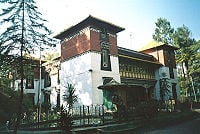 The Tibetology Museum displays rare Lepcha tapestries, masks and Buddhist statues. |
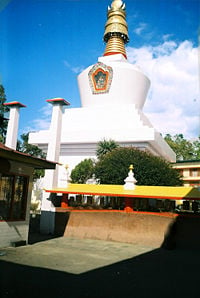 The Do-drul Chorten, built in 1945, is a famous Buddhist stupa within Gangtok city limits. |
 Rumtek Monastery, one of Buddhism's holiest monasteries, located on the outskirts of Gangtok. |
Gangtok, located at .[1], has an average elevation of 1437 metres (4714 feet). Situated in the lower Himalayas at an altitude of 1,780 metres (5,480 feet), in southeast Sikkim, Gangton serves as the state capital and the headquarters of the East Sikkim district. The town lies on one side of a hill, with "The Ridge," a promenade housing the governor's residence at one end and the palace, situated at an altitude of about 6,000 feet (1,828 m), at the other. The city overlooks the Ranikhola in the valley below. Most of the roads rise steeply, with the buildings built on compacted ground alongside them. The peaks of the snow-clad Himalayan range, including the world's third tallest peak, the Kanchenjunga, stand to the east of the city.
Because of its elevation and sheltered environment, Gangtok enjoys a mild, temperate climate all year round. Like most Himalayan towns, Gangtok has five seasons: summer, monsoons, autumn, winter and spring. Temperatures range from a high of 25 °C (77° F) in summer to a low of about 3 °C (37 °F) in winter. Snow falls rarely, and in recent times Gangtok has received snow only in 1990, 2004 and 2005. Temperatures seldom fall below freezing. During that season the weather may behave unpredicably, changing abruptly from bright sunshine and clear skies to heavy rain within a couple of hours.
During spring and autumn the weather turns generally sunny and mild. Owing to its elevation, fog often envelopes Gangtok during the monsoon and winter months. Between June and September (the monsoon months), the rain often causes landslides in the area. Labile rock formations general compose the lower Himalayas, making them prone to landslides even in dry seasons. Those landslides ocassionally result in the town being cut off from other parts of Sikkim.
Flora around Gangtok includes temperate, deciduous forests of poplar, birch, oak, and elm, as well as evergreen, coniferous trees of the wet alpine. Densely forested regions of those evergreens lie just around the town. Flower shows around the city often feature a wide variety of rare orchids. Sunflower, marigold, poinsettia, and other flowers bloom in November and December.
Bamboo grows in abundance along the slopes of Gangtok, providing a perennial source of spring water, which originates from the roots of the trees. In the lower reaches of the town, the vegetation graduates from alpine to subtropical and temperate deciduous.
Localities
The following areas comprise Gangtok:
- Palzor Stadium Road
Also called P.S. Road, it joins the low lying localities and suburbs with the main town. Palzor Stadium represents one of its major stops. As it nears its end, many hotels flank it , as well as the stop of the SNT or the Sikkim National Transport Buses. Some major hotels include Hotel Tibet, Hotel Mayur, Hotel Mt. Jopuno among others. The top floor of Hotel Tibet serves as the residence of the Dalai Lama when he visits Gangtok.
- Mahtama Gandhi Road
Also called M.G. Road, runs through the main commercial district of Gangtok. Many shops run by members of the Marwari community or migrant Biharis thrive there.
- Lal Bazar
The main market of the town occurs at the end of M.G. Road. Farmers from all over the state and adjoining areas including Nepal and Bhutan come to the market to sell their produce every weekend.
- Development Area
This fairly remote area, situated at a higher altitude, has been identified by the Government for future expansion. Also called Zero Point.
The Siniolchu Lodge, located near the Enchey Monastery, represents Gangtok's highest lodge. The lodge stands close to the state's main TV transmission tower.
Economy
Sikkim's mountainous terrain results in the lack of train or air links, limiting the area's potential for rapid industrial development. The government is the largest employer in the city, both directly and as contractors. The Sikkim Police also employs a large number of people to patrol the streets. The tourism industry provides employment to many people, with jobs ranging from drivers, shopkeepers to hoteliers. Gangtok receives around 200,000 tourists and earns Rs. 42 crores (9.7 million US $ annually. Its economy does not have a manufacturing base, but cottage industries such as watch-making, country-made alcohol and handicrafts are present. Among the handicrafts are the handmade paper industry made from various vegetable fibers or cotton rags. The main market in Gangtok provides many of the state's rural residents a place to offer their produce during the harvest seasons. The majority of the private business community is made up of Marwaris and Biharis.
As Sikkim is a frontier state, the Indian army maintains a large presence in the vicinity of Gangtok. This leads to a large population of semi-permanent residents who bring money into the local economy. The government of Sikkim also earns a lot of revenue from the numerous Playwin lottery centres (through online gambling) in the city. With the proposed opening of the Nathula Pass by the Union government in April 2006, Gangtok would benefit as a result of trade between India and Tibet. The Nathula Pass, located about fifty kilometres from Gangtok, used to be the primary route of the wool, fur and spice trade with Tibet until 1962, when the border was closed.
Civic governance
The civic infrastructure of Gangtok is overseen by the local municipal corporation whose councillors are directly elected by the people. The rural roads around Gangtok however, are maintained by the Border Roads Organisation, which is a part of the Indian army. As the headquarters of East Sikkim district, Gangtok also houses the offices of the district collector, an administrator appointed by the Union Government of India. Gangtok is also home to the Sikkim High Court, which is India's smallest High Court in terms of area and population of jurisdiction.
Gangtok does not have its own police commissionerate like other cities in India. Instead, it comes under the jurisdiction of the state police, which is headed by a Director General of Police, although an Inspector General of Police oversees the town.[2] Sikkim is known for its very low crime rate[3] and, though official statistics for urban crime are not available, Gangtok can indirectly be said to have one of the lowest crime statistics in India.
Infrastructure
Due to the abundance of natural springs in the vicinity, Gangtok does not suffer from a water shortage. It also has an almost uninterrupted electricity supply due to Sikkim's numerous hydroelectric power stations, and has the state's only cardiac hospital. Only 30% of Gangtok has a sewerage network and it is estimated that Rs. 28 crore (6.4 million US$) is required to upgrade the system. Though all buildings are supposed to be at a height of 15 metres (50 feet), this is openly flouted.[4] The city has enforced a ban on the use of plastic bags, in an effort to maintain its harmony with nature. Most shops and businesses pack their goods in paper bags.
Though Gangtok has many good schools, such as the Paljor Namgyal Girls School and Tashi Namgyal Academy (http://www.tnasikkim.com), it only has a single college offering a degree in arts and commerce.[5] Gangtok does not have a university within the city limits. However, just 8 km from here is the headquarters of the Sikkim Manipal University. There are other institutions offering diplomas in Buddhist literature, catering and other non-mainstream fields. As a result, many of its residents migrate to nearby Siliguri or Kolkata in pursuit of higher education. This problem has been compounded with the growing unemployment in the state, due to the lack of large-scale industries.
Media
Daily newspapers in English, Nepali, and Hindi are available in Gangtok. The Nepali newspapers are printed locally, whereas the Hindi and English newspapers are printed elsewhere. The English newspapers include The Statesman and The Telegraph, which are printed in Siliguri, as well as The Hindu and The Times of India, which are printed in Kolkata and was received after a one-day delay before but nowadays it comes daily.[6]
Gangtok has three cinema halls featuring Nepali, Hindi and English language films. The town also has a public library. There are Internet cafés in and around the city, but broadband connectivity is limited. Satellite dishes exist in most homes in the region and the channels available throughout India are also available here, along with a few Nepali language channels. The main service providers are Sikkim Cable, Dish TV, Doordarshan and Nayuma.[7] The national All India Radio is the only radio station in the city. BSNL, Reliance and Airtel have the three largest cellular networks in the town.
Transport
Taxis are the most widely available public transport within Gangtok. Most of Gangtok's residents stay within a few kilometres of the town centre and many have their own vehicles. Those residing some distance away generally make use of share-jeeps, a kind of public taxis. It is the only capital city in India to have a cable car, which was initially constructed for the elected MLA's to reach the state Assembly. It is now open to the public, though the distance covered is less than a kilometre (0.6 miles).
Gangtok is connected to the rest of India by an all-weather metalled highway, NH-31A, which links Gangtok to Siliguri, located 114 km (71 miles) away in the neighbouring state of West Bengal. The highway also provides a link to the neighbouring hill station towns of Darjeeling and Kalimpong, which are also the nearest urban areas. A regular jeep, van, and bus service links the towns to Gangtok and is the only route to the city from the rest of India. The nearest railhead connected to the rest of India is the station of New Jalpaiguri, a suburb of Siliguri, situated 124 km (77 miles) away from Gangtok. The nearest airport is Bagdogra Airport, 16 km (10 miles) from Siliguri. Although Gangtok does not have an airport, it is linked to Bagdogra airport, near Siliguri, via a regular helicopter service, the Sikkim Helicopter Service. A new airport, which would be the state's first, is slated to be opened by mid-2005.
Demographics
Ethnic Nepalis, who settled in the region during British rule, comprise the majority of Gangtok's fifty thousand residents. Lepchas, native to the land, and Bhutias also constitute a sizable portion of the populace. Additionally, a large number of Tibetans have immigrated to the town in recent years. Immigrant resident communities not native to the region include the Marwaris, who own most of the shops; the Biharis, who are employed in mostly blue collar jobs and the Bengalis.
Hinduism and Buddhism are the two largest religions in Gangtok. Gangtok also has a sizable Christian population, most of which is of Lepcha origin, who converted after British missionaries started preaching here in the late 19th century. The town has remained secular, having never witnessed any sort of inter-religious strife in its history. A mosque in downtown Gangtok also serves the small Muslim minority.
Nepali is the most widely spoken language in Gangtok. English and Hindi are also widely spoken and understood in most of Sikkim, particularly in Gangtok. Other languages spoken in Gangtok include Bhutia (Sikkimese), Tibetan and Lepcha.
As of the 2001 census of India,[8] Gangtok had a population of 29,162. Males constitute 54% of the population and females 46%. Gangtok has an average literacy rate of 79%, higher than the national average of 59.5%: male literacy is 82%, and female literacy is 75%. In Gangtok, 8% of the population is under 6 years of age.
Culture
Major Indian festivals, such as Diwali and Makar Sankranti (the popular Hindu festivals) along with the Buddhist festivals like Losar, Loosong, Bhumchu, Saga Dawa, Lhabab Duechen and Drupka Teshi are celebrated in Gangtok. During the Losar, the Tibetan New Year in mid-December, most government offices and tourist centres are closed for a week. In recent times, Christmas has also been celebrated in Gangtok.
Residents of Sikkim are music lovers and it is common to hear Western rock music being played in homes and restaurants. Hindi pop songs are also common. Indigenous Nepali rock, music suffused with a western rock beat and Nepali lyrics, is also particularly popular.
Football (soccer) and cricket are the two most popular sports. The Paljor Stadium, which hosts football matches, is the sole sporting ground in the city.
Noodle-based foods such as the thukpa, chowmein, thanthuk, fakthu, gyathuk and wonton, are relished in Gangtok. The momo is a popular snack made from vegetable, beef, or pork filling, which is steamed and served with a soup. Alcohol is cheap due to low excise duty in Sikkim. Beer, whiskey, rum and brandy are frequently consumed by both locals and non-locals.
The city's main landmark is a 200 foot (90 m) TV tower that can be viewed from afar.
City institutions
A centre of Buddhist learning and culture, Gangtok's most famous Buddhist institutions are the Enchey monastery, the Do-drul Chorten stupa complex and the Rumtek Monastery. The Enchey monastery is the city's oldest monastery and is the seat of the Nyingma order. The two-hundred year old baroque monastery houses images of gods, goddesses, and other religious artifacts. In the month of January, the Chaam, or masked dance, is performed with great fanfare. The Dro-dul Chorten is a stupa which was constructed in 1945 by Trulshi Rimpoché, head of the Nyingma order of Tibetan Buddhism. Inside this stupa are complete set of relics, holy books, and mantras. Surrounding the edifice are 108 Mani Lhakor, or prayer wheels. The complex also houses a religious school.
The Rumtek Monastery on the outskirts of the town is one of Buddhism's most sacred monasteries. The monastery is the seat of the Kagyu order, one of the major Tibetan sects, and houses some of the world's most sacred and rare Tibetan Buddhist scriptures and religious objects in its reliquary. Constructed in the 1960s, the building is modelled after a similar monastery in Lhasa, Tibet. Rumtek was the focus of international media attention[9] in 2000 after the seventeenth Karmapa, one of the four holiest lamas, fled Lhasa and sought refuge in the monastery.
The Namgyal Research Institute of Tibetology, better known as the Tibetology Museum, houses a huge collection of masks, Buddhist scriptures, statues, and tapestries. It has over two hundred Buddhist icons, and is a centre of study of Buddhist philosophy. The Ganesh Tok and the Hanuman Tok, dedicated to the Hindu gods Ganpati and Hanuman and housing important Hindu temples, are located in the upper reaches of the town.
The Himalayan Zoological Park exhibits the fauna of the Himalayas in their natural habitats. The zoo features the Himalayan Black Bear, the barking deer, the snow leopard, the civet cat, red pandas and the spotted deer. The Jawaharlal Nehru Botanical Gardens, near Rumtek, houses many species of bamboo and as many as fifty different species of tree, including many oaks.
ReferencesISBN links support NWE through referral fees
- Holidaying in Sikkim and Bhutan – published by Nest and Wings— ISBN 81-87592-07-9
- Sikkim — Land of Mystic and Splendour – published by Sikkim Tourism
- Manorama Year Book 2003 – ISBN 81-900461-8-7
Ecotourism and Conservation Society of Sikkim is one of the leading NGOs which spearheads the ecotourism movement in the state of Sikkim. A locally driven initiative, you can visit the ECOSS resource centre located in Gangtok to interact and meet the team to understand the initiatives that is being undertaken in SIkkim and in the North East.
Notes
- ↑ Falling Rain Genomics, Inc - Gangtok
- ↑ List of IPS officers and place of posting
- ↑ Crimes Under the Indian Penal Code Snapshot
- ↑ Template:Dlw
- ↑ Educational institutes of Sikkim, Sikkim info
- ↑ Newspapers, Sikkim info
- ↑ Entertainment in Sikkim, Sikkim info
- ↑ GRIndia
- ↑ Losing Its Karmapa: A Monastery Goes Dark, Lara Wozniak Time Asia, 2001-06-18, Vol 157 No.24
External links
- Travel guide to Gangtok from Wikitravel
- Community forum for Gangtok
- Sikkim info
- Namgyal Institute of Tibetology, Sikkim
| |||||
| |||||
Credits
New World Encyclopedia writers and editors rewrote and completed the Wikipedia article in accordance with New World Encyclopedia standards. This article abides by terms of the Creative Commons CC-by-sa 3.0 License (CC-by-sa), which may be used and disseminated with proper attribution. Credit is due under the terms of this license that can reference both the New World Encyclopedia contributors and the selfless volunteer contributors of the Wikimedia Foundation. To cite this article click here for a list of acceptable citing formats.The history of earlier contributions by wikipedians is accessible to researchers here:
The history of this article since it was imported to New World Encyclopedia:
Note: Some restrictions may apply to use of individual images which are separately licensed.
